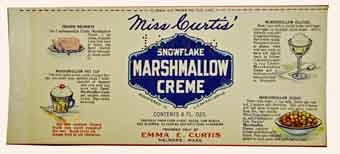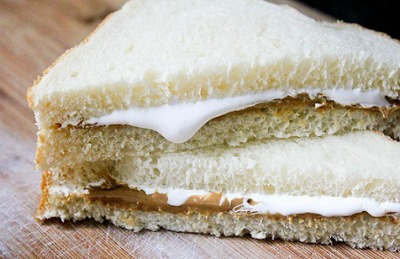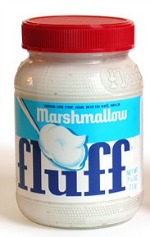What is a Fluffernutter?
It is not just a regular sandwich – but a Fluffernutter Sandwich!
Photo from From Away website.
Flutternutter – Registered trademark of Durkee-Mower Inc.
A Fluffernutter Sandwich is a calorie-laden sandwich made with two slices of bread layered with peanut butter and Marshmallow Fluff, and sometimes along with the occasional banana.
People will eat their peanut butter on all types of sandwiches and with all types of toppings. The most unique and unusual is the Fluffernutter Sandwich of the New England area of the United States. Generations of New Englanders fondly associate Marshmallow Fluff with their childhood as it has been a childhood favorite for many raised in the northeastern United States. The term fluffernutter is also be used to describe other food items, primarily desserts, that have both peanut butter and marshmallow creme.
The Fluffernutter sandwich is more than a beloved memory of childhood, it is a local tradition. As a traditional food of New England, it goes right alongside the baked beans and clam chowder.
Marshmallow Fluff is a blend of corn syrup, sugar, dried egg white, and vanilla flavoring. Learn how to make Homemade Marshmallow Fluff/Cream.
The Fluffernutter Song:
Oh you need fluff, fluff, fluff
To make a fluffernutter
Marshmallow fluff
And lots of peanut butter.
First you spread, spread, spread
Your bread with peanut butter
And marshmallow fluff
And have a fluffernutter.
When you enjoy, enjoy, enjoy
Your fluff and peanut butter
You’re glad you have enough for another fluffernutter.
History of Marshmallow Creme/Fluff and Fluffernutter Sandwich:
Marshmallow candy dates back to ancient Egypt where it was a honey-based candy flavored and thickened with the sap of the root of the Marsh-Mallow plant (althea officinalis). They mixed marsh mallow juice with honey to make a special candy that was reserved for the pharaohs and the gods. The Roman scholar Pliny believed that a daily drink of marshmallow juice would prevent all diseases and also cure most illnesses. The problem was that it wasn’t very palatable.
19th Century
Pharmacists in Paris, France extracted juice from the marsh mallow plant’s roots and cooked it with egg whites and sugar, then whipped the mixture into a foamy meringue that later hardened, creating a medicinal candy used to soothe children’s sore throats. People liked the new product and started eating it like candy.
By the late 19th century, confectioners had figured out how to mass-produce marshmallows, and they also figured out that they could replace the marshmallow juice with gelatin. By the turn of the century, marshmallows were a popular dessert ingredient. To make frostings and sauces out of them, the cook had to make the marshmallow creme first, which was a two-step process — you made sugar syrup, then you melted the marshmallows over a double boiler and combined them with the syrup.
20th Century
In the early 20 century, people believed any food could be improved by a white sauce. It was very much in fashion to use white sauces to dress up all kinds of food. Marshmallow frostings and sauces were popular dessert ingredients. Home cooks made their own marshmallow creme, either by mixing up the marshmallow ingredients from scratch or by melting down store-bought marshmallows and combining them with sugar syrup.
1910 – The Limpert Brothers brought out a product called Marshmallow Fluff, which was sold to soda fountains and ice cream parlors to put on ice cream sundaes.
1913 – Whitman’s, the people who make the Whitman’s Sampler, had a product called Marshmallow Whip.
 1914-1940 – The Curtis Marshmallow Factory was established by brother and sister, Emma (1863-1948) and Amory Curtis. Their signature product for the first 10 years of operation was Snowflake Marshmallow Creme (later known as SMAC), the first commercially successful shelf-stable marshmallow cream. The Curtises didn’t invent marshmallow creme, but they popularized it for home use. Emma started out going door to door in Melrose, bringing samples of her marshmallow creme on crackers. (Photo from the Melrose Mirror Newspaper.)
1914-1940 – The Curtis Marshmallow Factory was established by brother and sister, Emma (1863-1948) and Amory Curtis. Their signature product for the first 10 years of operation was Snowflake Marshmallow Creme (later known as SMAC), the first commercially successful shelf-stable marshmallow cream. The Curtises didn’t invent marshmallow creme, but they popularized it for home use. Emma started out going door to door in Melrose, bringing samples of her marshmallow creme on crackers. (Photo from the Melrose Mirror Newspaper.)
Emma was constantly developing new recipes, and she field-tested them on the family and on the neighborhood kids. In one of her radio shows she said she “served them marshmallow as a dressing on desserts, marshmallows on their cereal for breakfast, marshmallows in their cocoa, marshmallows in their salad dressing, marshmallows in their cakes, and as a sauce for every conceivable kind of jelly and pudding.”
1913 – Some of the very first Snowflake Marshmallow Creme labels from 1913 suggested using the product in sandwiches, topped with chopped nuts or olives. In a recipe leaflet published in 1914, Emma mentioned peanut butter as an accompaniment, and she also suggested that triangular sandwiches of butter and marshmallow creme on thinly sliced brown bread as a dainty lunch for children. What this means is that the town of Melrose may very well be the birthplace of what later came to be known as the Fluffernutter Sandwich.
In 1915, the Curtises scored a publicity coup: Snowflake Marshmallow Creme was awarded a gold medal at the 1915 Panama Pacific Exposition in San Francisco. This would be prominently featured in their advertising for years to come.
Emma’s research resulted in a series of small recipe booklets that were sent to customers on request. In a booklet published in 1918, Emma introduced her version of the Liberty Sandwich. NOTE: hamburgers were also known as Liberty Sandwiches during World War I (1914-1918). Peanut butter and fluff sandwiches, cut into dainty shapes, made a virtue out of necessity.
1917 – Archibald Query of Somerville, MA invented a special formula which he called marshmallow creme. He began making it in his kitchen and selling it door to door, but wartime shortages had forced him to close down.
1920 – After World War I was over, Archibald briefly formed a partnership with Durkee and Mower. Archibald sold his formula to H. Allen Durkee and Fred L. Mower for $500. They renamed their product “Toot Sweet Marshmallow Fluff.” The name was a play on a French phrase. With a barrel of sugar and a secondhand Ford, the pair began driving around looking for customers and selling door to door. They made their first sale of the sweet concoction in 1920, to a lodge in New Hampshire. By 1927, they were selling retail.
1930s – Durkee-Mower sponsored a weekly radio show in New England called the “Flufferettes” to advertise their product. The fifteen-minute show was aired on Sunday evenings just before the Jack Benny show. This show continued into the late 1940s.
21st Century
2006 – Massachusetts State Senator, Jarrett Barrios, outraged that his son Nathaniel, a third-grader, was given a Fluffernutter sandwich at his grade school in Cambridge, said he planned to file legislation that would ban schools from offering the local delicacy more than once a week as the main meal of the day. He was quoted as saying:
“As a parent, if I want my kid to eat healthy, he shouldn’t be able to go to school and get fluff or fluffernutters every day for school. We have the highest childhood obesity rate of any industrialized country in the world. We have the highest or the next to highest early-onset type-one diabetes.”
Senator Barrios’ bill was an amendment to a larger bill cracking down on junk food in schools. The move touched off a marshmallow war in the State House when legislators jumped to defend Fluffernutters. What Senator Barrios did not realize, was how much of a New England icon the sweet marshmallow spread slathered over white bread and twinned with peanut butter was. The bill to ban it drew legions of protective Fluffernutter patriots to arms. State Representative, Kathi-Anne Reinstein, said she would file legislation that would make the Fluffernutter the official sandwich of Massachusetts. Reinstein says she wants to preserve the local legacy, which is simply Marshmallow Fluff and peanut butter together between two slices of bread.
After the fight consumed the Massachusetts legislature for a week, Mr. Barrios said he planned to drop his proposal. All the talk about making the Fluffernutter Sandwich the official state sandwich was also dropped.
National Fluffernutter Day: Because of the debate over the bill, the town of Somerville, MA held it first annual tribute to Archibald Query and Marshmallow Fluff. in 2006, Somerville, MA. The festival was dubbed “What the Fluff.” October 8th was officially declared “National Fluffernutter Day.”
This Fluffernutter Sandwich recipe was shared to me by Mary Wright Huber of Worcester, MA. Mary says: I was born in Worcester, MA and grew up in northern CT. I lived along the CT/MA border area until I was 30, when I moved to Tucson, my current home. I certainly did not invent this sandwich. I believe the method is on the container, along with a perennial favorite fudge. Because Fluff is a regional food, as I had my mother (now deceased) start to ship me Fluff shortly after my relocation. She was so amazed in Arizona’s lack of Fluff, that she asked me, ” What do the feed their children?”
- 2 slices soft white bread like Wonder Bread
- Smooth peanut butter
- Marshmallow Fluff*
-
Spread one slice of bread with peanut butter.
-
Spread the other slice with Marshmallow Fluff.
-
Close bread slices with the peanut butter the Fluff sides touching.
-
Makes 1 sandwich.
* Learn how to make Homemade Marshmallow Fluff/Cream.



11 Responses to “Fluffernutter Sandwich History and Recipe”
Ann
It is called a Fluffernutter not a Flutternutter
Brenda
Thanks for the catch! We had some migration issues with the new site. The spelling has been corrected now.
Kim pascoe
We used to have Fluffernutter Sandwiches at camp made with a special recipe. The peanut butter and fluff was mixed with butter and whipped to a light fluffy mix. Have searched for years for the measurements but can’t find it anywhere. Can someone help me pass this summer tradition to my grandkids?
Wanda Cohea
Is marshmallow fluff the same as marshmallow cream?
Linda Stradley
I believe it is.
Robert( Bobby) Coveney sr
Gotta love that FLUFF . We were big on it in the 70s-80s. Our parents would throw that peanut butter and jelly w the fluff on a table Saturday afternoons. Also with some crackers for a fend for yourself day. We made triple deckers PBJ+FLUFF, put it in hot cocoa,put it in oatmeal,and just ate it off the spoon,haha. There was 11 kids and we were creative. I am today going to make a few of those sandwiches for my friends kids whom never had it today.
Noah Patenerd
I made this sandwich and tried to stick it on my head, but it did not work.
Chris
It’s not just a Massachusetts thing! Growing up in Scranton, Pa in the late 70’s-80’s fluffernutter sandwiches were always a treat for us kids. I still eat them, occasionally, today.
Laura Townsend
I started making these sandwiches without ever hearing it befor to help me gain weight. this was back in 1972.
Robert Jenkins
I too had Fluffernutters growing up in Southern Cali. I still make once in awhile today. They are amazing. Have you ever had a Peanut butter Pizza? That is great too. To make it you use peanut butter instead of the sauce then sausage and cheese. Its great. How about a Miracle Whip, peanut butter, and bacon sandwich? You might have guessed I love peanut butter.
MICHELLE APPLEBEE
Calorie laden? Not really, not anymore than a pb&j. If you use more than 1 tbsp of jelly, which is a serving size, a pb&j would actually have more calories as 2 tbsp of marshmallow creme or fluff, only has 40 calories and depending on the jelly anywhere from 40 to 50 plus calories, for 1 tbsp, unless its sugar free. So no worse than a pb&j, the only thing high in calories is the peanut butter which is actually the most healthy thing about this sandwich. Well of course that’s only if you use real peanut butter made from only peanuts and salt. I don’t know why they think it’s necessary to add all that other crap into it. Tastes much better without it. Just made myself a fluffernutter after many many years of not having one, think I’ll try it with some jelly next time.